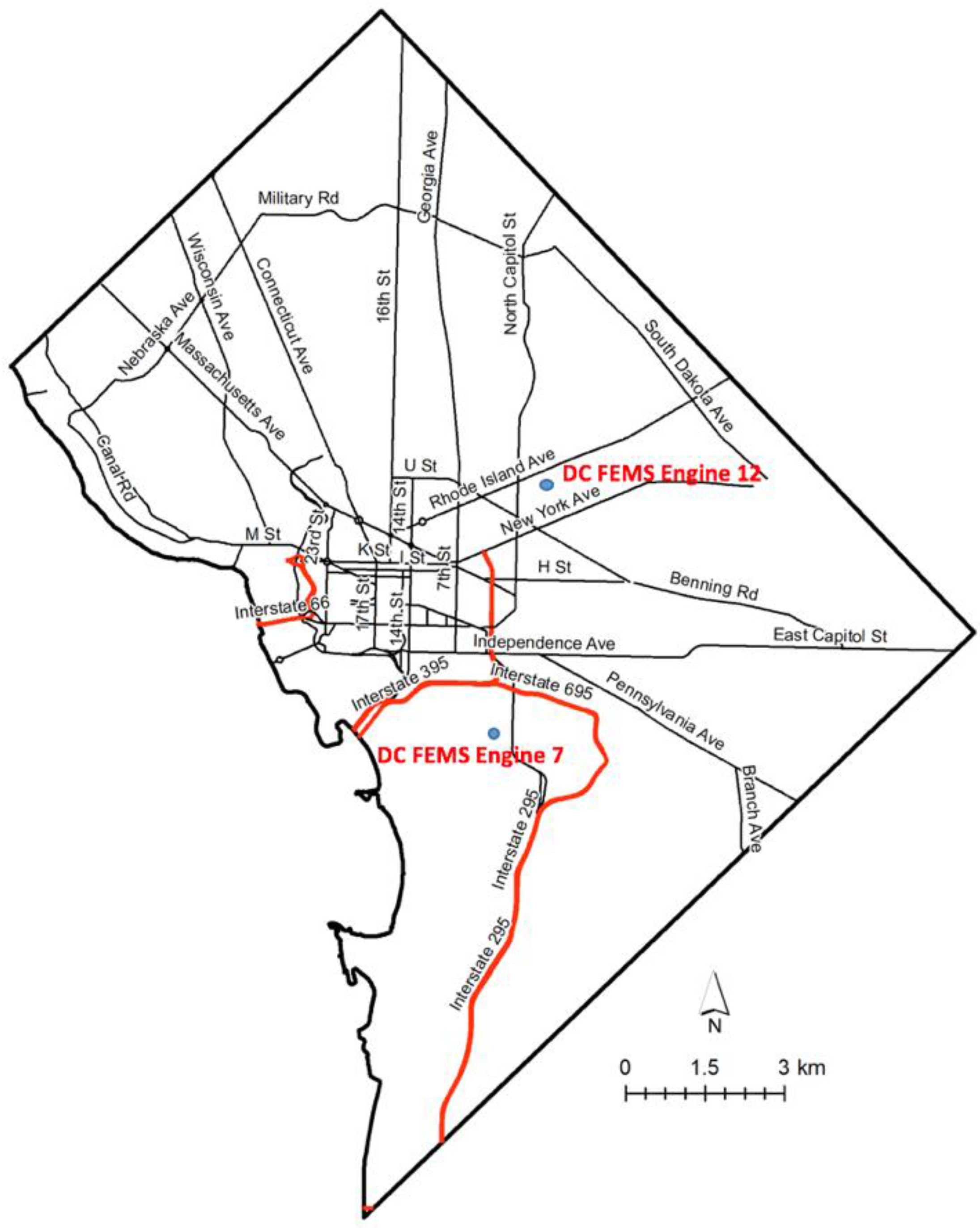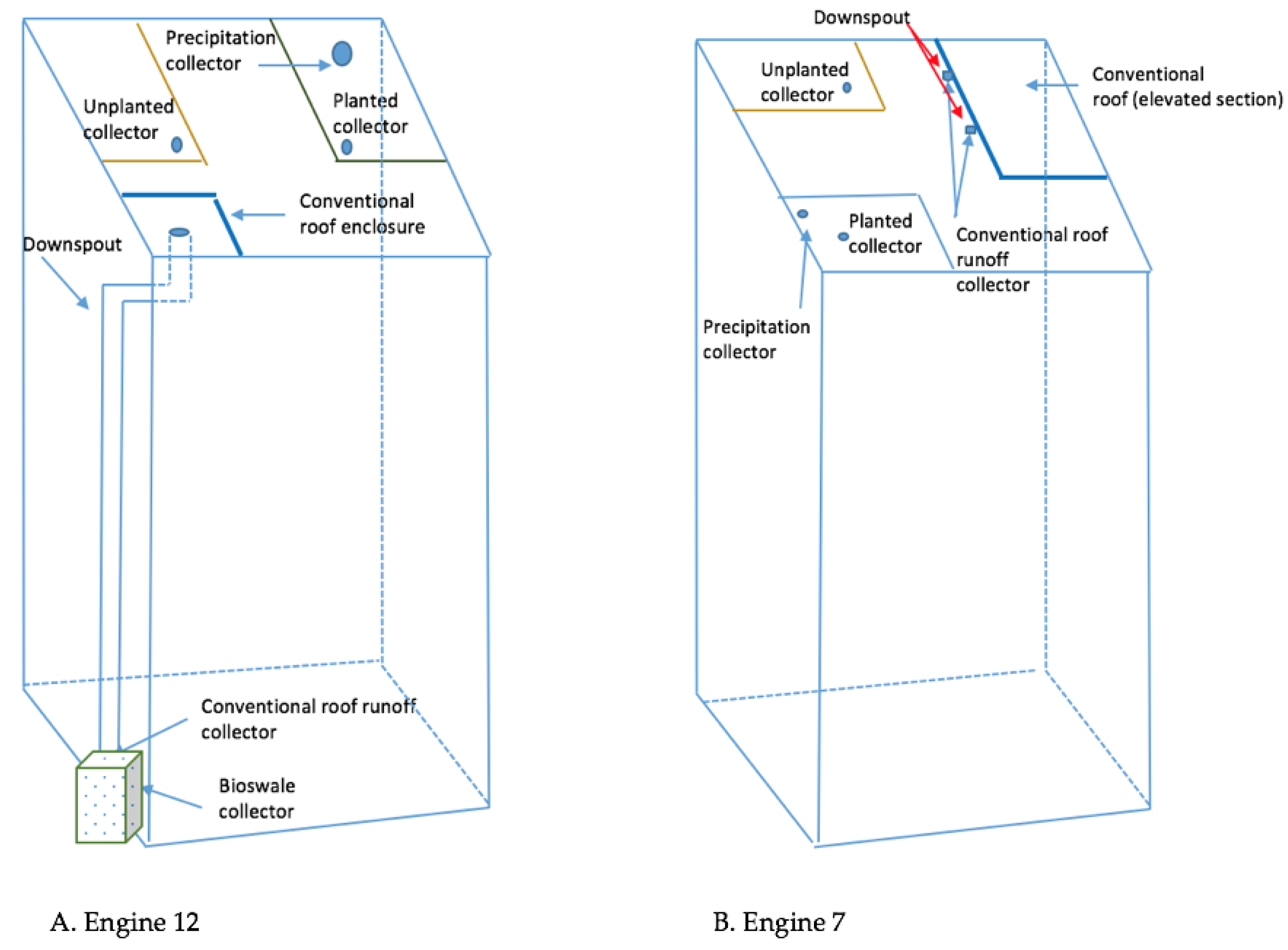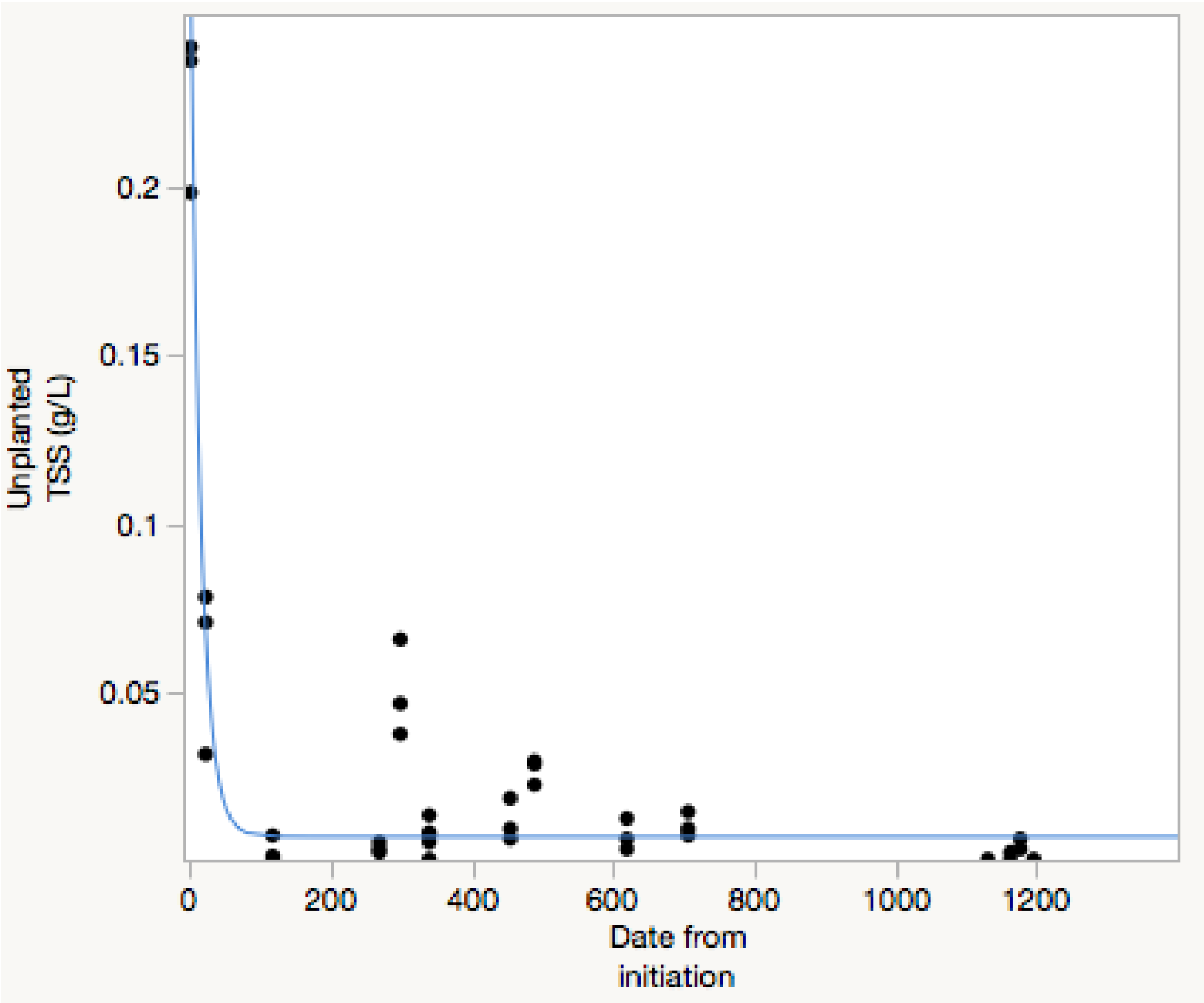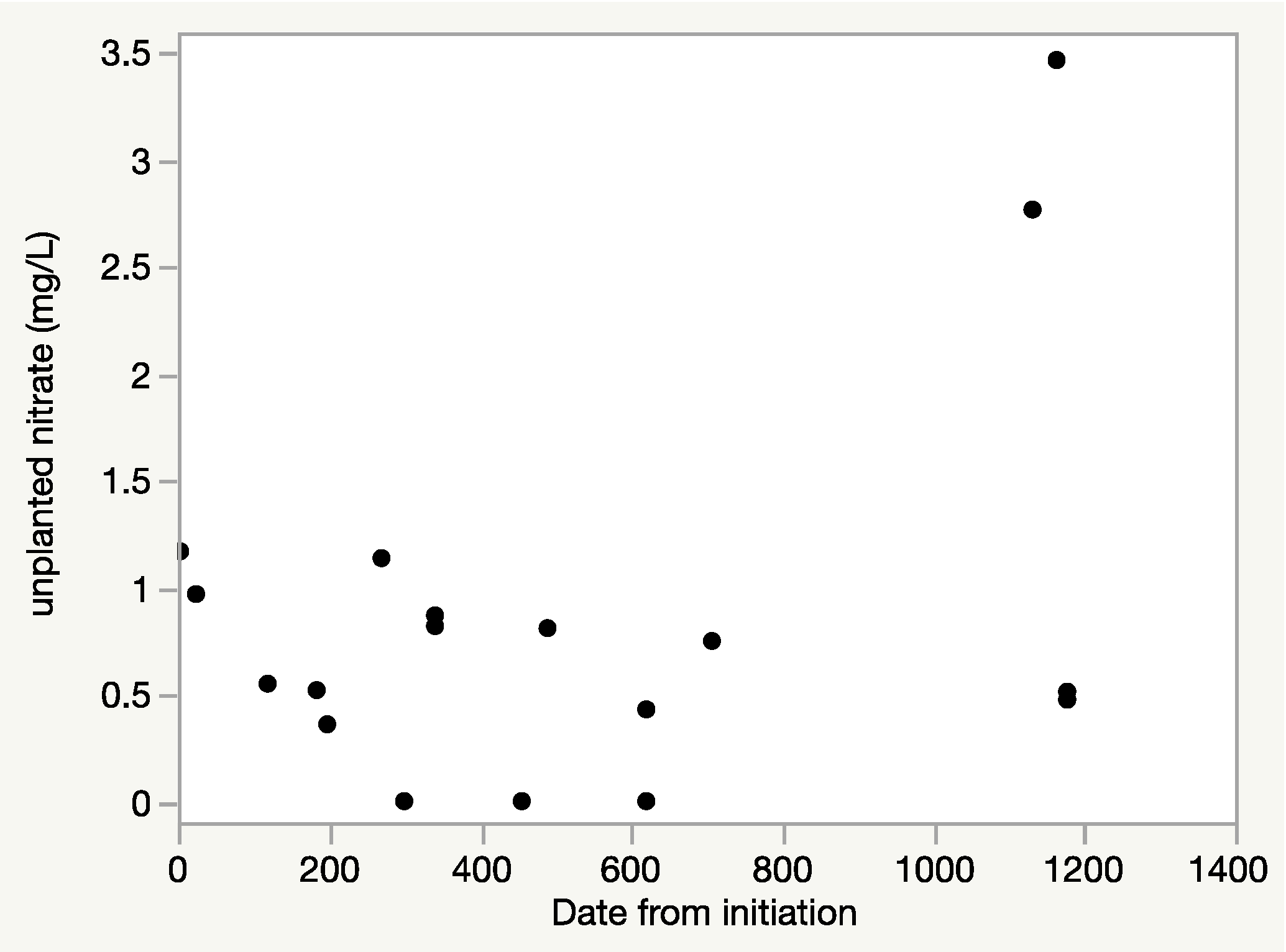Pollution Reduction in Throughflow from Vegetated and Non-Vegetated, Foam-Based Surfaces and Green Roofs
Abstract
:1. Introduction
2. Materials and Methods
2.1. Study Sites (D.C. Fire and Emergency Medical Services)
2.2. Aqualok™ Foam Panels/Bioswale and Conventional Roof Runoff
2.3. Sample Collection and Preparation
2.4. Sample Monitoring
2.5. Analysis and Statistics
3. Results
3.1. Precipitation versus Runoff
3.2. Engine 12 and 7: Averages
3.3. Engine 12 Only: Averages. Excluding First Three Months Post-Installation (July–September 2012)
3.4. Engine 12 over Time
4. Discussion
Aqualok™ Surfaces’ Performance over Time
5. Conclusions
Author Contributions
Funding
Acknowledgments
Conflicts of Interest
References
- Sustainability DC 2011. Available online: http://www.sustainabledc.org/wp-content/uploads/2017/03/SDC_Plan_2016_compressed2.pdf (accessed on 8 February 2018).
- Spolek, G. Performance monitoring of three ecoroofs in Portland, Oregon. Urban Ecol. 2008, 11, 349–359. [Google Scholar] [CrossRef]
- Getter, K.L.; Rowe, D.B. The role of extensive green roofs in sustainable development. HortScience 2006, 41, 1276–1285. [Google Scholar]
- Teemusk, A.; Mander, Ü. The use of green roofs for the mitigation of environmental problems in urban area. WIT Trans. Ecol. Environ. 2006, 93, 3–17. [Google Scholar]
- Dunnett, N.; Kingsbury, N. Planting Green Roofs and Living Walls; Timber Press: Portland, OR, USA, 2004. [Google Scholar]
- Gregoire, B.G.; Clausen, J.C. Effect of a modular extensive green roof on stormwater runoff and water quality. Ecol. Eng. 2011, 37, 963–969. [Google Scholar] [CrossRef]
- Teemusk, A.; Mander, Ü. Rainwater runoff quantity and quality performance form a green roof: The effects of short term effects. Ecol. Eng. 2007, 30, 271–277. [Google Scholar] [CrossRef]
- Teemusk, A.; Mander, Ü. The influence of green roofs on runoff water quality: A case study from Estonia. Water Resour. Manag. 2011, 25, 3699–3713. [Google Scholar] [CrossRef]
- Speak, A.F.; Rothwell, J.J.; Lindley, S.J.; Smith, C.L. Metal and nutrient dynamics on an aged intensive green roof. Environ. Pollut. 2014, 184, 33–43. [Google Scholar] [PubMed]
- U.S. Green Building Council. Leadership in Energy and Design (LEED): Reference Guide for Building Design and Construction; U.S. GBC Printing Offices: Washington, DC, USA, 2013. [Google Scholar]
- Czemiel Berndtsson, J.; Emilsson, T.; Bengtsson, L. The influence of extensive vegetated roofs on water quality. Sci. Total Environ. 2006, 355, 48–63. [Google Scholar] [CrossRef] [PubMed]
- Czemiel Berndtsson, J. Green roof performance towards management of runoff water quantity and quality. Ecol. Eng. 2010, 36, 351–360. [Google Scholar] [CrossRef]
- Van Seters, T.; Rocha, L.; Smith, D.; MacMillan, G. Evaluation of green roofs for runoff retention, runoff quality, and leachability. Water Qual. Res. J. Can. 2009, 44, 33–47. [Google Scholar] [CrossRef]
- Wang, H.; Qin, L.; Hu, Y. Are green roofs a source or sink of runoff pollutants? Ecol. Eng. 2017, 107, 65–70. [Google Scholar] [CrossRef]
- Li, Y.; Babcock, R.W. Green roofs against pollution and climate change. A review. Agron. Sustain. Dev. 2014, 34, 695–705. [Google Scholar] [CrossRef]
- Buffam, I.; Mitchell, M.E.; Durtsche, R.D. Environmental divers of seasonal variation in green roof runoff water quality. Ecol. Eng. 2017, 91, 506–514. [Google Scholar] [CrossRef]
- Mitchell, M.E.; Matter, S.F.; Durtsche, R.D.; Buffam, I. Elevated phosphorus: Dynamics during four years of green roof development. Urban Ecosyst. 2017, 20, 1121–1133. [Google Scholar] [CrossRef]
- MacAvoy, S.E.; Plank, K.; Mucha, S.; Williamson, G. Effectiveness of foam-based green surfaces in reducing nitrogen and suspended solids in an urban installation. Ecol. Eng. 2016, 91, 257–264. [Google Scholar] [CrossRef]
- Hathaway, A.M.; Hunt, W.F.; Jennings, G.D. A field study of green roof hydrological and water quality performance. Am. Soc. Agric. Biol. Eng. 2008, 51, 37–44. [Google Scholar]
- Kohler, M.; Schmidt, M.; Grimme, F.W.; Laar, M.; de Assuncao Paiva, V.L.; Tavares, S. Green roofs in temperate climates and in the hot-humid tropics—far beyond the aesthetics. Environ. Manag. Health 2002, 13, 382–391. [Google Scholar] [CrossRef]
- Niu, H.; Clark, C.; Zhou, J.; Adriaens, P. Scaling of economic benefits from green roof implementation in Washington DC. Environ. Sci. Technol. 2010, 44, 4302–4308. [Google Scholar] [CrossRef] [PubMed]
- Todorov, D.; Driscoll, C.T.; Todorova, S.; Montesdeoca, M. Water quality function of an extensive vegetated roof. Sci. Total Environ. 2018, 625, 928–939. [Google Scholar] [CrossRef] [PubMed]
- Currie, B.A.; Bass, B. Estimates of air pollution mitigation with green plants and green roofs using the UFORE model. Urban Ecosyst. 2008, 11, 409–422. [Google Scholar] [CrossRef]
- Speak, A.F.; Rothwell, J.J.; Lindley, S.J.; Smith, C.L. Urban particulate pollution reduction by four species of green roof vegetation in a UK city. Atmos. Environ. 2012, 61, 283–293. [Google Scholar] [CrossRef]
- Yang, J.; Gong, P. Quantifying air pollution removal by green roofs in Chicago. Atmos. Environ. 2008, 42, 7266–7273. [Google Scholar] [CrossRef]
- Russell, K.M.; Galloway, J.N.; Macko, S.A.; Moody, J.J.; Scudlark, J.R. Sources of nitrogen in wet deposition to the Chesapeake Bay region. Atmos. Environ. 1998, 32, 2453–2465. [Google Scholar] [CrossRef]







| Collection Point | Engine 12 | Engine 7 |
|---|---|---|
| unplanted Aqualok™ | X | X |
| planted Aqualok™ | X | X |
| bioswale Aqualok™ | X | |
| “untreated” runoff | X | X |
| precipitation | X | X |
| Event Collection Dates | Locations Sampled | Precipitation Amount (cm) | Days from Study Initiation |
|---|---|---|---|
| 19-Jul-12 | Engine 12 | 0.45 | 1 |
| 10-Aug-12 | Engine 12 | 1.5 | 22 |
| 13-Nov-12 | Engine 12 | 2.67 | 117 |
| 17-Jan-13 | Engine 12 | 2.74 | 182 |
| 31-Jan-13 | Engine 12 | 2.51 * | 196 |
| 12-Apr-13 | Engine 12 | 2.03 | 268 |
| 12-May-13 | Engine 12 | 1.4 | 298 |
| 23-Jun-13 | Engine 12 | 1.17 | 339 |
| 16-Oct-13 | Engine 12 and 7 | 12.27 ** | 454 |
| 19-Nov-13 | Engine 12 and 7 | 1.24 | 488 |
| 30-Mar-14 | Engine 12 and 7 | 5.26 *** | 619 |
| 25-Jun-14 | Engine 12 and 7 | 1.43 | 706 |
| 11-July-14 | Engine 12 | 1.93 | 722 |
| 9-Oct-14 | Engine 7 | 0.38 | 824 |
| 14-Oct-14 | Engine 7 | 1.27 **** | 829 |
| 16-Oct-14 | Engine 7 | 3.66 | 831 |
| 24-Aug-15 | Engine 12 and 7 | 1.04 | 1131 |
| 12-Sept-15 (runoff only) | Engine 12 and 7 | 4.06 | 1146 |
| 29-Sept-15 | Engine 12 and 7 | 4.19 | 1163 |
| 9-Oct-15 | Engine 12 and 7 | 1.02 | 1190 |
| 28-Oct-15 | Engine 12 and 7 | 1.65 | 1203 |
| Collection Point | TSS (g/L) | TOC (mg/L) | Total P (mg/L) | NH4 (mg/L) | NO3 (mg/L) |
|---|---|---|---|---|---|
| Precipitation | 0.026 ± 0.047 (N = 45) A | 3.6 ± 1.8 (N = 16) A | 0.02 ± 0.04 (N = 17) A | 0.11 ± 0.14 (N = 17) A | 0.13 ± 0.16 (N = 17) A |
| Roof runoff | 0.091 ± 0.104 (N = 46) B | 5.4 ± 3.5 (N = 16) A,B | 0.03 ± 0.06 (N = 17) A,C | 0.22 ± 0.35 (N = 17) A,B | 0.44 ± 0.32 (N = 17) B |
| Bioswale Aqualok | 0.048 ± 0.040 (N = 33) B | 14.7 ± 10.6 (N = 12) C | 0.12 ± 0.20 (N = 12) A,C | 0.32 ± 0.73 (N = 12) A,B | 0.41 ± 0.46 (N = 12) A,B |
| Unplanted Aqualok | 0.026 ± 0.057 (N = 45) A | 6.5 ± 3.0 (N = 15) B | 0.11 ± 0.28 (N = 16) A,C | 0.15 ± 0.14 (N = 16) A,B | 0.95 ± 0.95 (N = 16) B |
| Planted Aqualok | 0.051 ± 0.111 (N = 36) A | 16.6 ± 7.3 (N = 13) C,D | 0.69 ± 0.55 (N = 14) B | 0.28 ± 0.38 (N = 14) B | 0.81 ± 1.13 (N = 14) B |
| Collection Point | TSS (g/L) | TOC (mg/L) | Total P (mg/L) | NH4 (mg/L) | NO3 (mg/L) |
|---|---|---|---|---|---|
| Precipitation | 0.017 ± 0.025 (N = 36) A | 3.2 ± 2.1 (N = 12) A | 0.02 ± 0.03 (N = 13) A | 0.13 ± 0.15 (N = 13) A | 0.21 ± 0.33 (N = 13) A |
| Conventional roof runoff | 0.096 ± 0.163 (N = 33) B | 13.8 ± 9.4 (N = 11) B | 0.04 ± 0.05 (N = 12) A,B | 0.45 ± 0.79 (N = 12) A | 0.51 ± 1.24 (N = 12) C,A |
| Unplanted Aqualok | 0.017 ± 0.020 (N = 33) C,A | 10.7 ± 4.6 (N = 11) B | 0.04 ± 0.05 (N = 11) A,B | 0.14 ± 0.24 (N = 11) A | 1.12 ± 0.93 (N = 11) B |
| Planted Aqualok | 0.051 ± 0.065 (N = 28) D,B | 18.0 ± 24.7 (N = 10) B | 0.06 ± 0.05 (N = 10) B | 0.14 ± 0.23 (N = 10) A | 0.64 ± 0.36 (N = 10) B |
| Collection Point | TSS (g/L) | TOC (mg/L) | Total P (mg/L) | NH4 (mg/L) | NO3 (mg/L) |
|---|---|---|---|---|---|
| Precipitation | 0.020 ± 0.042 (N = 42) A | 3.46 ± 1.89 (N = 14) A | 0.025 ± 0.037 (N = 15) C | 0.114 ± 0.151 (N = 15) A | 0.125 ± 0.168 (N = 15) A |
| Conventional roof runoff | 0.083 ± 0.106 (N = 40) B,C | 5.02 ± 3.13 (N = 14) A,B | 0.033 ± 0.061 (N = 15) C,D | 0.221 ± 0.360 (N = 15) A,B | 0.478 ± 0.339 (N = 15) B |
| Bioswale Aqualok | 0.037 ± 0.035 (N = 27) C | 13.7 ± 10.16 (N = 10) C | 0.143 ± 0.207 (N = 10) A,E | 0.374 ± 0.796 (N = 10) A,B | 0.363 ± 0.401 (N = 10) A,B |
| Unplanted Aqualok | 0.008 ± 0.013 (N = 39) D | 6.12 ± 2.94 (N = 13) B | 0.127 ± 0.291 (N = 14) C,E | 0.169 ± 0.138 (N = 14) A,B | 0.932 ± 1.018 (N = 15) B |
| Planted Aqualok | 0.010 ± 0.009 (N = 30) E,A | 15.26 ± 7.07 (N = 11) C | 0.636 ± 0.567 (N = 12) B | 0.241 ± 0.327 (N = 12) B | 0.413 ± 0.524 (N = 12) B |
© 2018 by the authors. Licensee MDPI, Basel, Switzerland. This article is an open access article distributed under the terms and conditions of the Creative Commons Attribution (CC BY) license (http://creativecommons.org/licenses/by/4.0/).
Share and Cite
Mucha, S.; Williamson, G.; MacAvoy, S.E. Pollution Reduction in Throughflow from Vegetated and Non-Vegetated, Foam-Based Surfaces and Green Roofs. Nitrogen 2020, 1, 21-33. https://doi.org/10.3390/nitrogen1010004
Mucha S, Williamson G, MacAvoy SE. Pollution Reduction in Throughflow from Vegetated and Non-Vegetated, Foam-Based Surfaces and Green Roofs. Nitrogen. 2020; 1(1):21-33. https://doi.org/10.3390/nitrogen1010004
Chicago/Turabian StyleMucha, Sydney, Glenn Williamson, and Stephen E. MacAvoy. 2020. "Pollution Reduction in Throughflow from Vegetated and Non-Vegetated, Foam-Based Surfaces and Green Roofs" Nitrogen 1, no. 1: 21-33. https://doi.org/10.3390/nitrogen1010004




